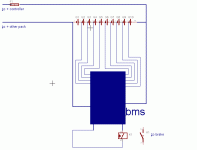dean
1 µW
- Joined
- Dec 3, 2007
- Messages
- 3
thanks fechter!
ok so if the larger controller draws more amps than the batteries BMS can handle, then how many amps can i safely draw from the batteries?
I have 4 batteries in the circuit wired up as per the schematics on
http://www.neodymics.com/Images/V24ProtoSwitch070818E.pdf
Or the otherway around, how many batteries do i need to be able to draw 35A?
Also - this seems odd to me since some of the dewalt powertools are rated at 750W - this equates to about 20A - from one battery, I'm trying to draw 35A from 4 batteries - i.e. 9A each - am i missing something?
cheers,
Dean.
ok so if the larger controller draws more amps than the batteries BMS can handle, then how many amps can i safely draw from the batteries?
I have 4 batteries in the circuit wired up as per the schematics on
http://www.neodymics.com/Images/V24ProtoSwitch070818E.pdf
Or the otherway around, how many batteries do i need to be able to draw 35A?
Also - this seems odd to me since some of the dewalt powertools are rated at 750W - this equates to about 20A - from one battery, I'm trying to draw 35A from 4 batteries - i.e. 9A each - am i missing something?
cheers,
Dean.





